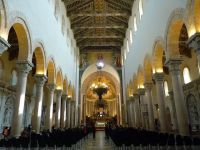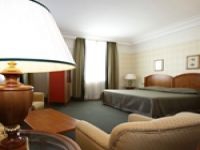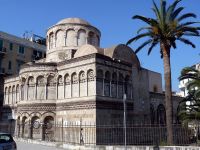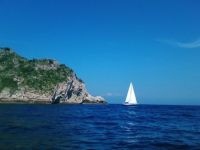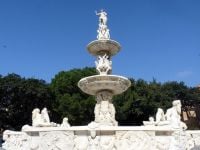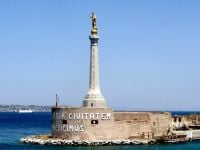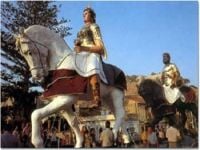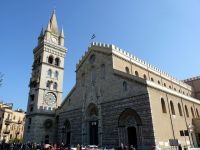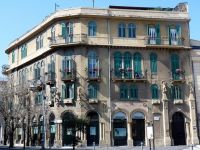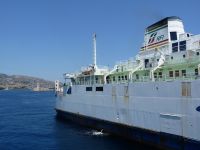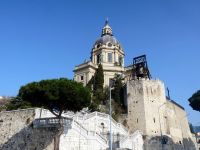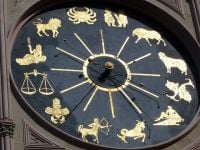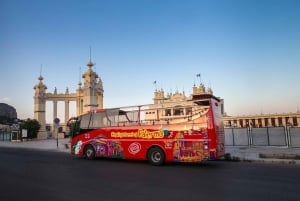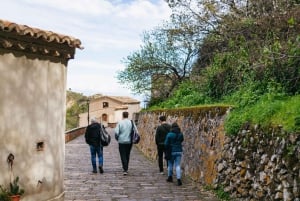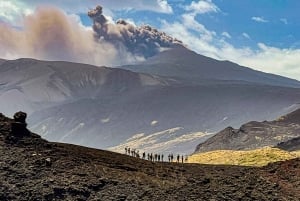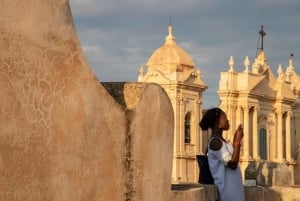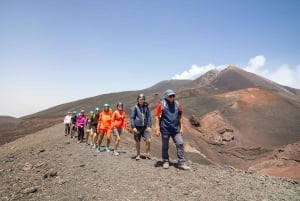Messina
Messina is, and has always been, the gateway to Sicily. If you are travelling to Sicily by your own car or by train, and take a ferry from Reggio Calabria’s port Villa San Giovanni, Messina will be the first part of Sicily you see. It is a good introduction – the harbour and the views of the Messina Strait. showcase pretty much of the natural beauty of the area, framed by the Peloritani mountains.
Welcome to beautiful Sicily!
You don’t have to be afraid any more to be eaten up by the ancient Greek sea monsters Scylla and Charybdis, who are living since millennia at both sides of the Straits. Scylla, who inhabits the coastline of Messina almost ended Odysseus' fated voyage. Nowadays they are peaceful monsters, Scylla is guarding the Straits of Messina in Sicily, Charybdis on the other side at the Calabrian coast.
Most travellers use Messina as a point of arrival and swing off immediately to other places. But Messina has a long history, and even if there is not much left of the old town, there are still quite a few interesting things to see in this third largest town of Sicily.
Did you know that St. Ignatius de Loyola founded the world’s first Jesuit college in Messina? Or that William Shakespeare chose the town as the setting for " Much Ado About Nothing"? Or that Cervantes recovered in Messina’s hospital after th eBatlle of Lepanto?
Messina once was the capital of Sicily, settled by the Greek, then dominated by the Romans, was invaded by the Byzantines, followed by Arabs and Normans. Its history sounds like a series of disasters. In the year 1743 nearly 50,000 people died in the plague, in 1783 an earthquake destroyed the town. At the beginning of the last century, in 1908, Messina was a flourishing town that became in between minutes a heap of rubbles. On 28th of December early in the morning, an enormous earthquake followed by a tsunami levelled the city almost completely. Two thirds of the inhabitants died. The modern Messina looks flat, because tall buildings are not permitted – a precaution of seismic town planning. Like the inhabitants of Catania, people rebuilt their city again and again. In 1943 Messina suffered the last blow: the Operation Husky took place. The city was the last bastion of German defences, and British and US forces bombed the town to the grounds, killing thousands. But Messina remains Sicily’s gateway, where hundreds of passengers are shuttled every day between Calabria and Sicily. The crossing takes only 20 minutes, so if you are staying in the area you could easily make a day trip to Reggio Calabria and visit to the Archaeological Museum which boasts beautiful and rare finds, amongst them the famous life-sized Greek bronze statues “Bronzi di Riace”.
Since 1985 a giant bridge across the Strait has been under discussion – 60 m wide, 3.3 km long, supported by two pillars of 382 m, each of it higher than the Empire State Building in New York. It would accommodate a railway line for up to 200 trains daily, two walkways and six freeway lanes. In 2006 the project was cancelled, in 2009 revived - as part of Berlusconi’s new public works program. Costs of the bridge: 6.1 billion Euro!
Today Messina presents itself as a modern city with wide squares, long streets and plenty of green. It is unusually clean and looks somewhat tidy, on the contrary to many other Sicilian towns. Messina welcomes visitors with ear-deafening horn concerts and an enormous traffic, day and night. In fact the whole city seems to be an entire traffic jam. Messina is not a beautiful but a rich city, a bustling, vivid town with elegant boutiques – the political, cultural and economical centre of Sicily’s north-east.
Despite the fact that Messina has been devastated by invaders, bombs and earthquakes, some old buildings and art works have survived. Between the central station and the dome square you will find one of the very few quarters where narrow roads, small shops and little cafés, and dwelling-houses built around 1900, featuring stucco-framed windows and large entrances, define a glimpse of the old Messina.
Things to do and see in Messina
Piazza del Duomo di Messina
At the heart of the dome square, the “Fontana di Orione” (Orion Fountain) deserves a stop and a close look - it is a masterwork of the Florentine Renaissance. The Cathedral features a beautiful mosaic floor and a brightly painted ceiling, but more interesting is the bell tower which holds the largest mechanical clock in the world, built by the Ungerer Company of Strasbourg in 1933.
Chiesa della Santissima Annunziata dei Catalani
Just off the dome square stands the finest example in Sicily of Byzantine architecture with Sicilian-Arab-Norman influences: the “Chiesa della Santissima Annunziata dei Catalani”. Built under KIng William II The Good on the remains of an old pagan temple this church is a magnificent expression of architecture – Byzantine, Norman, Romanesque and Arab styles blend in perfectly.
Duomo di Messina
The most interesting thing about Messina's Cathedral is the bell tower with the largest mechanical clock in the world. The campanile’s mechanically animated statues illustrate the most important events of the city’s history. Every day at noon the show begins with the roar of a lion, and the gilded automatons of the bell tower spring into action. You will see the figures of two young women ringing church bells. Their names are Dina and Chiarenza, and thanks to them the Sicilians won the decisive battle of the Sicilian Vespers against the hated French rulers of King Charles of Anjou.
Chiesa Santa Maria degli Alemanni di Messina
This church is a very rare example of pure Gothic architecture in Sicily. Formerly it was a chapel of the Teutonic knights – hence the name “Saint Mary of the Alemans”.
Galleria d’Arte Contemporanea di Messina
The regional museum of Messina hosts valuable and notable paintings, amongst them some of the Renaissance painter Antonello da Messina, the towns’ most famous son, and two works of Caravaggio which he painted in 1608 and 1609 during his brief asylum in Sicily, since he was wanted for homicide in Italy.
Faro San Ranieri
Lighthouse-fans should pay a visit to the 460 year old lighthouse of San Ranieri
Il Pilone
In the year 1957 two pylons were built to carry an overhead power line that should bring electricity from the mainland of Italy to Sicily, one in Messina, one in Calabria across the Strait. At their time these pylons were the highest in the world. Today an underwater cable transports the electric power, and “Il Pilone” has become a tourist attraction (free access).
Capo Peloro – for beach & seafood aficionados
Another place to visit in Messina is Capo Peloro, a wonderful coastline with some fine sandy beaches and great seafood dining.
Capo Peloro is the setting to one of the many legends of Sicily, the story of the fisherman’s son Nicola, the “Colapesce”, who was swimming with the fish and mermaids, and who is, second to legend, responsible for the earthquakes in the area of Messina
Shopping in Messina
A good (indeed a very good) reason to pay a visit to Messina is for shopping.
A short ten minutes walk from the central station you will find shopper’s paradise around Piazza Cairoli. Take your time to wander the main streets Viale Europa and Viale San Martino, to meander into the side streets and alleys, stroll designer shops and small boutiques. In this district you will find everything from bargains to designer clothes (and much cheaper than in Taormina for example). See more at Shopping
Restaurants in Messina
In Messina you will not have any difficulties to locate good eating at affordable prices. This place serves up fantastic seafood and offers a very savoury local cuisine. Best places in town for a good pizza and local food are around Piazza del Popolo, Piazza Cairoli (regain strength after your shop-til-you-drop tour), Montalto and Cristo Re.
See more at our Restaurants page
Accommodation in Messina
Most people overnight in Messina when they are waiting for early transport connections the next day. If you plan to stay a little longer than one night: Messina features some hotels in the centre (from two star Hotel Cairoli – rooms can be noisy – to four star Grand Hotel Liberty next to the train station and Hotel Messenion). There are also two campsites near the town.
Please see more at Accommodation
Events in Messina
Messina’s biggest events take place at mid August, when Sicily is packed with tourists and the island is virtually sinking. On 14th of August, Mata and Grifone, the founders of Messina, are celebrated. Two giant statues of eight metres height, made of paper mache, are carried during a procession through the town centre on equally gigantic horses. On 15th of August there are processions in honour of Saint Mary: “La Vara Festa della Madonna Assunta”. Find more annual festivals in Sicily here
How to get to Messina
By car
We suppose that our attentive readers and potential visitors certainly know what’s coming now: we absolutely do NOT recommend going to Messina by car for a day visit! Messina is the total traffic chaos, not only by our but even by Sicilian standards. So leave the car where it is and hop on a bus or train. In Messina itself there are local buses and a tram to get you around. If you do not believe us and want to give it a try: you can leave your car at the parking near the central station and Hotel Liberty.
By bus & train
Messina is connected by local bus services, such as SAIS Linee, and by trains to Taormina, Catania, Cefalù and Palermo.
When you are travelling by train to Sicily: the trains are loaded in Villa San Giovanni in Calabria on the ferries to make the crossing over the Straits of Messina, which can be a rather lengthy process at times. There are also regular departures for foot passengers from Reggio Calabria
By cruise
Most cruise liners passing Sicily dock in Messina. You can book on board excursions to the most beautiful and interesting spots in Sicily, such as the Aeolian Islands, Cefalù and Palermo, Taormina, Syracuse, Catania and Mount Etna.
By ferry
Frequent hydrofoils and ferries carry passengers, cars and trains across the Straits of Messina from Villa San Giovanni to Messina. When you are travelling by car to Sicily, just take the motorway to Reggio Calabria, exit at Villa San Giovanni and follow the signs. Tickets are available at the port.
Sailing Sicily


